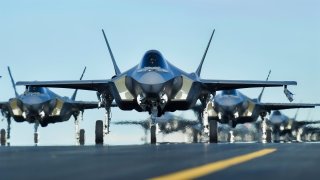Racing Against Time: The Pentagon's Plan to Deploy 664 F-35s by 2029
The Pentagon has finally cleared the F-35 Joint Strike Fighter for full-rate production, aiming to procure 664 units for the Air Force, Navy, and Marine Corps between Fiscal Years 2025 and 2029.
Summary and Key Points: The Pentagon has finally cleared the F-35 Joint Strike Fighter for full-rate production, aiming to procure 664 units for the Air Force, Navy, and Marine Corps between Fiscal Years 2025 and 2029.
-After years of delays and "development hell," this rapid production push aims to address strategic gaps as older fourth-generation aircraft age out and global threats, particularly from China, loom large.
-The expedited production plan is crucial to ensuring the U.S. military's air superiority against near-peer rivals, with hopes that global tensions remain manageable until the F-35 fleet is fully operational by 2029.
The Pentagon Finally Reaches Full Production Swing with the F-35
Earlier this year, the Pentagon cleared the F-35 Joint Strike Fighter for full-rate production.
In keeping with that plan, the U.S. Department of Defense outlined the ways in which it intends to procure a total of 664 F-35s for the Air Force, Marine Corps, and Navy collectively between Fiscal Year 2025 and FY 2029.
The plan is for an expedited procurement process to ensure that the three services operating F-35 variants will have enough of these birds for the next two decades.
The F-35 is to be the backbone of the U.S. military’s air fleet. The Air Force, Navy, and Marine Corps have all procured variants of this advanced, expensive bird. Now the military is rushing production of these overdue warbirds because fourth-generation warplanes are aging out of their life cycles, and threats to America’s global position are growing fast.
From “Development Hell” to Full Production: the F-35 Saga
With the military retiring many of its fourth-generation birds and engaging in a slap-dash attempt to keep some of them operating beyond their intended lifespans, strategic gaps are forming in America’s power projection capabilities in the airspace domain.
The three branches with airpower elements are struggling to keep up with increased demand. Eventually, their existing fleets will be unsustainable.
That’s why the Pentagon is pressing hard for rapid production of the F-35 between now and the end of the decade.
The F-35 was meant to be in full production years ago. It was stuck in what Hollywood types might refer to as “development hell.” Now that the Pentagon has mostly ironed out the wrinkles in the F-35 program, they’re going full bore. Better late than never, but even the rosiest Pentagon threat assessments indicate that the enemies of the United States, notably China, will be ready for near-peer combat as soon as 2027.

Lets’ Hope America’s Enemies Wait Until 2029 to Attack…
At that time, none of the branches will have enough of these warbirds in their fleets to effectively counter a near-peer rival like China. I suppose the best we can hope for is that cooler heads will prevail between now and 2029, when the Americans believe they will have achieved full maturation and saturation of their forces with the new F-35s.
Already, however, the limits of this hope are being tested. Everywhere Americans look around the world, near-peer rivals, rogue states, and terrorist groups are clamoring for conflict.
America must be ready now.
The F-35 is available, but not in the numbers that the Pentagon believes it will need to reliably defeat these adversaries. Still, the Pentagon’s plan to expedite orders of these birds should show any reader that the geopolitical situation facing the United States is dire.
According to Defense News, the “Air Force plans to bed down 25 F-35As in fiscal 2026.” This is the first major move by the Air Force to complete their goal of total acquisition by 2029.
At least the military is finally actualizing its plans for the F-35. That’s a big win, considering the complications that have beset the decades-old program. Let’s just hope that America’s rivals stay their hand until 2029-2030, when the U.S. military’s warplane fleet is ready.
Otherwise, we’re going to be in for it.
Author Experience and Expertise: Brandon J. Weichert
Brandon J. Weichert, a National Interest national security analyst, is a former Congressional staffer and geopolitical analyst who is a contributor at The Washington Times, the Asia Times, and The-Pipeline. He is the author of Winning Space: How America Remains a Superpower, Biohacked: China’s Race to Control Life, and The Shadow War: Iran’s Quest for Supremacy. His next book, A Disaster of Our Own Making: How the West Lost Ukraine, is due October 22 from Encounter Books. Weichert can be followed via Twitter @WeTheBrandon.
All images are Creative Commons or Shutterstock.
From the Vault
Russia Freaked Out: Why the U.S. Navy 'Unretired' the Iowa-Class Battleships
Battleship vs. Battlecruiser: Iowa-Class vs. Russia's Kirov-Class (Who Wins?)


